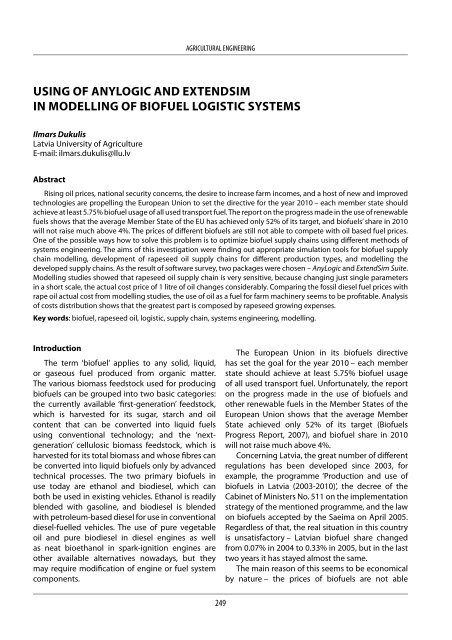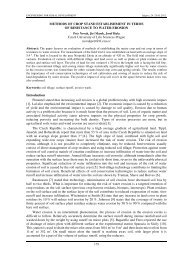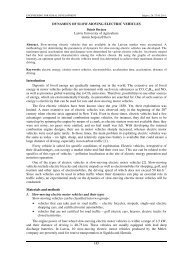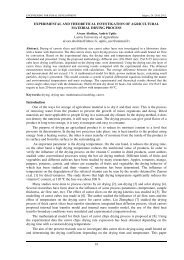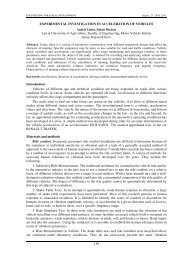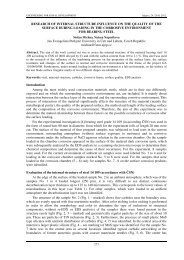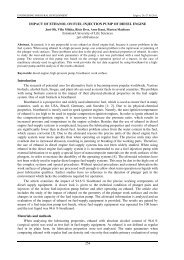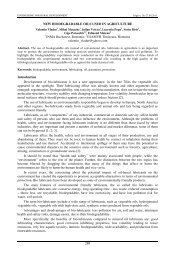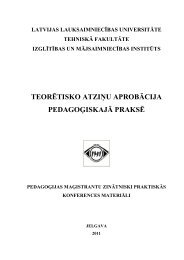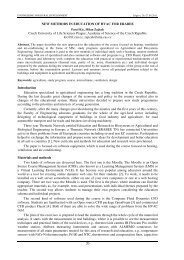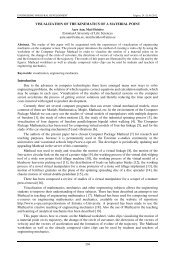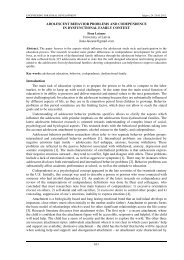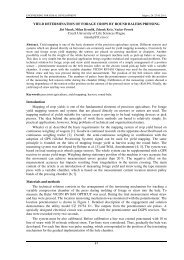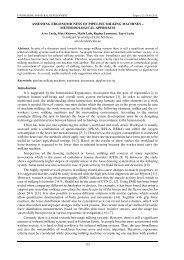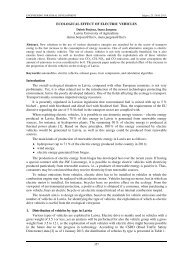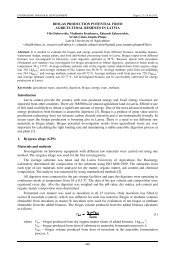using of anylogic and extendsim in modelling of
using of anylogic and extendsim in modelling of
using of anylogic and extendsim in modelling of
You also want an ePaper? Increase the reach of your titles
YUMPU automatically turns print PDFs into web optimized ePapers that Google loves.
AGRICULTURAL ENGINEERING<br />
USING OF ANYLOGIC AND EXTENDSIM<br />
IN MODELLING OF BIOFUEL LOGISTIC SYSTEMS<br />
Ilmars Dukulis<br />
Latvia University <strong>of</strong> Agriculture<br />
E-mail: ilmars.dukulis@llu.lv<br />
Abstract<br />
Ris<strong>in</strong>g oil prices, national security concerns, the desire to <strong>in</strong>crease farm <strong>in</strong>comes, <strong>and</strong> a host <strong>of</strong> new <strong>and</strong> improved<br />
technologies are propell<strong>in</strong>g the European Union to set the directive for the year 2010 – each member state should<br />
achieve at least 5.75% bi<strong>of</strong>uel usage <strong>of</strong> all used transport fuel. The report on the progress made <strong>in</strong> the use <strong>of</strong> renewable<br />
fuels shows that the average Member State <strong>of</strong> the EU has achieved only 52% <strong>of</strong> its target, <strong>and</strong> bi<strong>of</strong>uels’ share <strong>in</strong> 2010<br />
will not raise much above 4%. The prices <strong>of</strong> different bi<strong>of</strong>uels are still not able to compete with oil based fuel prices.<br />
One <strong>of</strong> the possible ways how to solve this problem is to optimize bi<strong>of</strong>uel supply cha<strong>in</strong>s <strong>us<strong>in</strong>g</strong> different methods <strong>of</strong><br />
systems eng<strong>in</strong>eer<strong>in</strong>g. The aims <strong>of</strong> this <strong>in</strong>vestigation were f<strong>in</strong>d<strong>in</strong>g out appropriate simulation tools for bi<strong>of</strong>uel supply<br />
cha<strong>in</strong> modell<strong>in</strong>g, development <strong>of</strong> rapeseed oil supply cha<strong>in</strong>s for different production types, <strong>and</strong> modell<strong>in</strong>g the<br />
developed supply cha<strong>in</strong>s. As the result <strong>of</strong> s<strong>of</strong>tware survey, two packages were chosen – AnyLogic <strong>and</strong> ExtendSim Suite.<br />
Modell<strong>in</strong>g studies showed that rapeseed oil supply cha<strong>in</strong> is very sensitive, because chang<strong>in</strong>g just s<strong>in</strong>gle parameters<br />
<strong>in</strong> a short scale, the actual cost price <strong>of</strong> 1 litre <strong>of</strong> oil changes considerably. Compar<strong>in</strong>g the fossil diesel fuel prices with<br />
rape oil actual cost from modell<strong>in</strong>g studies, the use <strong>of</strong> oil as a fuel for farm mach<strong>in</strong>ery seems to be pr<strong>of</strong>itable. Analysis<br />
<strong>of</strong> costs distribution shows that the greatest part is composed by rapeseed grow<strong>in</strong>g expenses.<br />
Key words: bi<strong>of</strong>uel, rapeseed oil, logistic, supply cha<strong>in</strong>, systems eng<strong>in</strong>eer<strong>in</strong>g, modell<strong>in</strong>g.<br />
Introduction<br />
The term ‘bi<strong>of</strong>uel’ applies to any solid, liquid,<br />
or gaseous fuel produced from organic matter.<br />
The various biomass feedstock used for produc<strong>in</strong>g<br />
bi<strong>of</strong>uels can be grouped <strong>in</strong>to two basic categories:<br />
the currently available ‘first-generation’ feedstock,<br />
which is harvested for its sugar, starch <strong>and</strong> oil<br />
content that can be converted <strong>in</strong>to liquid fuels<br />
<strong>us<strong>in</strong>g</strong> conventional technology; <strong>and</strong> the ‘nextgeneration’<br />
cellulosic biomass feedstock, which is<br />
harvested for its total biomass <strong>and</strong> whose fibres can<br />
be converted <strong>in</strong>to liquid bi<strong>of</strong>uels only by advanced<br />
technical processes. The two primary bi<strong>of</strong>uels <strong>in</strong><br />
use today are ethanol <strong>and</strong> biodiesel, which can<br />
both be used <strong>in</strong> exist<strong>in</strong>g vehicles. Ethanol is readily<br />
blended with gasol<strong>in</strong>e, <strong>and</strong> biodiesel is blended<br />
with petroleum-based diesel for use <strong>in</strong> conventional<br />
diesel-fuelled vehicles. The use <strong>of</strong> pure vegetable<br />
oil <strong>and</strong> pure biodiesel <strong>in</strong> diesel eng<strong>in</strong>es as well<br />
as neat bioethanol <strong>in</strong> spark-ignition eng<strong>in</strong>es are<br />
other available alternatives nowadays, but they<br />
may require modification <strong>of</strong> eng<strong>in</strong>e or fuel system<br />
components.<br />
The European Union <strong>in</strong> its bi<strong>of</strong>uels directive<br />
has set the goal for the year 2010 – each member<br />
state should achieve at least 5.75% bi<strong>of</strong>uel usage<br />
<strong>of</strong> all used transport fuel. Unfortunately, the report<br />
on the progress made <strong>in</strong> the use <strong>of</strong> bi<strong>of</strong>uels <strong>and</strong><br />
other renewable fuels <strong>in</strong> the Member States <strong>of</strong> the<br />
European Union shows that the average Member<br />
State achieved only 52% <strong>of</strong> its target (Bi<strong>of</strong>uels<br />
Progress Report, 2007), <strong>and</strong> bi<strong>of</strong>uel share <strong>in</strong> 2010<br />
will not raise much above 4%.<br />
Concern<strong>in</strong>g Latvia, the great number <strong>of</strong> different<br />
regulations has been developed s<strong>in</strong>ce 2003, for<br />
example, the programme ‘Production <strong>and</strong> use <strong>of</strong><br />
bi<strong>of</strong>uels <strong>in</strong> Latvia (2003-2010)’, the decree <strong>of</strong> the<br />
Cab<strong>in</strong>et <strong>of</strong> M<strong>in</strong>isters No. 511 on the implementation<br />
strategy <strong>of</strong> the mentioned programme, <strong>and</strong> the law<br />
on bi<strong>of</strong>uels accepted by the Saeima on April 2005.<br />
Regardless <strong>of</strong> that, the real situation <strong>in</strong> this country<br />
is unsatisfactory – Latvian bi<strong>of</strong>uel share changed<br />
from 0.07% <strong>in</strong> 2004 to 0.33% <strong>in</strong> 2005, but <strong>in</strong> the last<br />
two years it has stayed almost the same.<br />
The ma<strong>in</strong> reason <strong>of</strong> this seems to be economical<br />
by nature – the prices <strong>of</strong> bi<strong>of</strong>uels are not able<br />
249
USING OF ANYLOGIC AND EXTENDSIM IN MODELLING OF BIOFUEL LOGISTIC SYSTEMS<br />
Ilmars Dukulis<br />
to be <strong>in</strong> competition with gasol<strong>in</strong>e <strong>and</strong> diesel<br />
prices. If governments <strong>and</strong> others wish to exp<strong>and</strong><br />
production <strong>and</strong> use <strong>of</strong> bi<strong>of</strong>uels significantly at the<br />
domestic <strong>and</strong> global levels, they will need to have<br />
an effective wide-rang<strong>in</strong>g policy strategy. The most<br />
common policies support<strong>in</strong>g bi<strong>of</strong>uels today are<br />
blend<strong>in</strong>g m<strong>and</strong>ates <strong>and</strong> exemptions from fuel taxes.<br />
Other policy <strong>in</strong>struments are loan guarantees; tax<br />
<strong>in</strong>centives for agriculture <strong>and</strong> forestry, consumers<br />
<strong>and</strong> manufactures; preferential government<br />
purchas<strong>in</strong>g policies; <strong>and</strong> research, development,<br />
<strong>and</strong> demonstration fund<strong>in</strong>g for current <strong>and</strong> nextgeneration<br />
bi<strong>of</strong>uels <strong>and</strong> technologies (Bi<strong>of</strong>uels for<br />
Transport …, 2007).<br />
System <strong>in</strong>puts<br />
(customer requirements)<br />
Another possible way to enlarge the production<br />
<strong>and</strong> use <strong>of</strong> bi<strong>of</strong>uels is to optimize bi<strong>of</strong>uel supply<br />
cha<strong>in</strong>s <strong>us<strong>in</strong>g</strong> different methods <strong>of</strong> systems<br />
eng<strong>in</strong>eer<strong>in</strong>g. Systems eng<strong>in</strong>eer<strong>in</strong>g can be def<strong>in</strong>ed<br />
as a structured process for arriv<strong>in</strong>g at a f<strong>in</strong>al design<br />
<strong>of</strong> a system. The f<strong>in</strong>al design is selected from a<br />
number <strong>of</strong> alternatives that would accomplish the<br />
same objectives <strong>and</strong> considers the total life-cycle <strong>of</strong><br />
the project <strong>in</strong>clud<strong>in</strong>g not only the technical merits<br />
<strong>of</strong> potential solutions but also the costs <strong>and</strong> relative<br />
value <strong>of</strong> alternatives. The most common structure<br />
<strong>of</strong> the systems eng<strong>in</strong>eer<strong>in</strong>g process is shown <strong>in</strong><br />
Figure 1 (Bahill <strong>and</strong> Giss<strong>in</strong>g, 1998).<br />
Problem statement<br />
Design <strong>of</strong> alternatives<br />
System modell<strong>in</strong>g<br />
Integration with sub-systems<br />
Launch<strong>in</strong>g the system<br />
Re-evaluation<br />
Measur<strong>in</strong>g the system<br />
System outputs<br />
Consider<strong>in</strong>g that system modell<strong>in</strong>g plays a very<br />
important role <strong>in</strong> eng<strong>in</strong>eer<strong>in</strong>g process structure, it<br />
is chosen for this <strong>in</strong>vestigation. Before start<strong>in</strong>g the<br />
modell<strong>in</strong>g process, identification <strong>of</strong> the system is<br />
very important.<br />
In this <strong>in</strong>vestigation the system is a bi<strong>of</strong>uel<br />
logistic or supply cha<strong>in</strong>. The different possible<br />
Figure 1. The systems eng<strong>in</strong>eer<strong>in</strong>g process structure.<br />
conversion routes for the production <strong>of</strong> different<br />
bi<strong>of</strong>uel types play a central role <strong>in</strong> the model.<br />
These conversion routes are def<strong>in</strong>ed by <strong>in</strong>terl<strong>in</strong>ked<br />
subprocesses, which are def<strong>in</strong>ed by <strong>in</strong>put <strong>and</strong><br />
output. The simplified general outl<strong>in</strong>e <strong>of</strong> conversion<br />
route def<strong>in</strong>ition is shown <strong>in</strong> Figure 2 (Van Thuijl et<br />
al., 2003).<br />
Crop<br />
production<br />
Crop<br />
pre-process<strong>in</strong>g<br />
Raw material<br />
production<br />
Fuel grade<br />
production<br />
National<br />
market<br />
Figure 2. General outl<strong>in</strong>e <strong>of</strong> conversion route def<strong>in</strong>ition for the model.<br />
Crop production denotes the production <strong>of</strong> biomass<br />
<strong>and</strong> biomass residues from agriculture, forestry,<br />
<strong>and</strong> <strong>in</strong>dustry. The pre-process<strong>in</strong>g <strong>of</strong> the crop may consist<br />
<strong>of</strong> several pre-treatment steps. After pre-process<strong>in</strong>g<br />
<strong>of</strong> the biomass it is converted <strong>in</strong>to a raw material<br />
(for example, bio-crude or raw ethanol), which serves<br />
as an <strong>in</strong>put for the production <strong>of</strong> fuel grade bi<strong>of</strong>uels.<br />
Both raw material production <strong>and</strong> fuel grade produc-<br />
250
USING OF ANYLOGIC AND EXTENDSIM IN MODELLING OF BIOFUEL LOGISTIC SYSTEMS<br />
Ilmars Dukulis<br />
tion may consist <strong>of</strong> several conversion processes. F<strong>in</strong>ally,<br />
the produced bi<strong>of</strong>uels are transported to the national<br />
market, where distribution to end-consumers<br />
takes place (<strong>in</strong> either pure form or blends with conventional<br />
automotive fuels).<br />
Analys<strong>in</strong>g the exist<strong>in</strong>g solutions <strong>in</strong> modell<strong>in</strong>g<br />
<strong>of</strong> bi<strong>of</strong>uel supply cha<strong>in</strong>s, the first ones were<br />
found relat<strong>in</strong>g biomass fuel supply <strong>and</strong> collection<br />
correspond<strong>in</strong>gly <strong>in</strong> the Netherl<strong>and</strong>s <strong>and</strong> the United<br />
K<strong>in</strong>gdom (Allen et al., 1998; De Mol et al., 1997). The<br />
most valuable <strong>in</strong>formation from these <strong>in</strong>vestigations<br />
was used <strong>in</strong>put <strong>and</strong> output data for modell<strong>in</strong>g, but<br />
researchers didn’t specify the used modell<strong>in</strong>g tools.<br />
Another problem to use these models as analogues<br />
for bi<strong>of</strong>uel logistic cha<strong>in</strong> modell<strong>in</strong>g <strong>in</strong> Latvia is<br />
different modell<strong>in</strong>g <strong>in</strong>put parameters, for example,<br />
raw materials, distances between objects, network<br />
<strong>of</strong> roads, etc.<br />
The most fundamental <strong>and</strong> recent <strong>in</strong>vestigations<br />
<strong>in</strong> the modell<strong>in</strong>g <strong>of</strong> bi<strong>of</strong>uel supply cha<strong>in</strong>s were<br />
carried out with<strong>in</strong> the European Commissionsupported<br />
project ‘Clear Views on Clean Fuels’<br />
(Wakker et al., 2005). The objective <strong>of</strong> this research<br />
was to develop a cost efficient bi<strong>of</strong>uel strategy for<br />
Europe <strong>in</strong> terms <strong>of</strong> bi<strong>of</strong>uel production, cost <strong>and</strong><br />
trade, <strong>and</strong> to assess its larger impact on bioenergy<br />
markets <strong>and</strong> trade up to 2030. Based on the biomass<br />
availability <strong>and</strong> associated costs with<strong>in</strong> EU countries,<br />
scenarios for bi<strong>of</strong>uels production <strong>and</strong> cost was<br />
constructed <strong>us<strong>in</strong>g</strong> quantitative modell<strong>in</strong>g tools.<br />
Comb<strong>in</strong><strong>in</strong>g this with data on bi<strong>of</strong>uel conversion<br />
technologies <strong>and</strong> transport <strong>of</strong> biomass <strong>and</strong> bi<strong>of</strong>uels,<br />
the lowest cost bi<strong>of</strong>uel supply cha<strong>in</strong> given a certa<strong>in</strong><br />
dem<strong>and</strong> predeterm<strong>in</strong>ed by the bi<strong>of</strong>uels directive<br />
was designed. Two complementary models were<br />
developed <strong>in</strong> this research, the BIOTRANS model<br />
<strong>and</strong> the ChalmersVIEWLS model.<br />
The BIOTRANS model needs the follow<strong>in</strong>g <strong>in</strong>puts:<br />
costs <strong>and</strong> potentials <strong>of</strong> biomass resources (<strong>in</strong>clud<strong>in</strong>g<br />
organic waste fractions <strong>and</strong> residues) <strong>in</strong> <strong>in</strong>dividual<br />
countries, data on the possible conversion routes<br />
conta<strong>in</strong><strong>in</strong>g different process steps, data on the<br />
national <strong>and</strong> <strong>in</strong>ternational transportation <strong>and</strong><br />
h<strong>and</strong>l<strong>in</strong>g <strong>of</strong> the different products <strong>in</strong>volved <strong>and</strong> data<br />
on policy <strong>in</strong>centives. The model has been formulated<br />
as a multi commodity network flow model<br />
connected by country nodes. The ChalmersVIEWLS<br />
is a regionalised energy system model. It has three<br />
end-use sectors: electricity, transportation fuels,<br />
<strong>and</strong> heat. Specific energy dem<strong>and</strong> scenarios are<br />
developed for each <strong>of</strong> the three sectors. In addition<br />
to energy dem<strong>and</strong> <strong>and</strong> costs, the supply potentials,<br />
energy conversion characteristics <strong>and</strong> expansion<br />
limitations, the <strong>in</strong>itial capital stock <strong>and</strong> trade<br />
parameters are exogenously def<strong>in</strong>ed.<br />
Unfortunately, reports on these modell<strong>in</strong>g<br />
studies don’t share with used modell<strong>in</strong>g equations<br />
<strong>and</strong> used computer s<strong>of</strong>tware also. Only results <strong>in</strong><br />
graphical <strong>and</strong> numerical form are available. Another<br />
problem is that these models are too global. For<br />
example, if the distance from Gulbene to Ventspils<br />
<strong>in</strong> European model is <strong>in</strong>considerable, than <strong>in</strong><br />
modell<strong>in</strong>g <strong>of</strong> bi<strong>of</strong>uel supply cha<strong>in</strong> <strong>in</strong> Latvia scale it<br />
is very significant.<br />
Regardless <strong>of</strong> this, analysis <strong>of</strong> these <strong>in</strong>vestigations<br />
were very useful, especially studies <strong>of</strong> background<br />
document for modell<strong>in</strong>g <strong>us<strong>in</strong>g</strong> the BIOTRANS model<br />
(Van Thuijl et al., 2003). As an example conversion<br />
route for pure vegetable oil from this document is<br />
shown <strong>in</strong> Figure 3.<br />
Solvent<br />
Solvent (recycled)<br />
Oil seeds<br />
production<br />
Wash<strong>in</strong>g, flak<strong>in</strong>g,<br />
cook<strong>in</strong>g, press<strong>in</strong>g<br />
Oil<br />
extraction<br />
Distillation<br />
National pure<br />
vegetable oil market<br />
Oil seeds<br />
at border<br />
Seed cakes<br />
Pure vegetable oil<br />
at border<br />
Figure 3. Conversion route for pure vegetable oil.<br />
251
USING OF ANYLOGIC AND EXTENDSIM IN MODELLING OF BIOFUEL LOGISTIC SYSTEMS<br />
Ilmars Dukulis<br />
S<strong>in</strong>ce the pure vegetable oil cha<strong>in</strong> is the simplest<br />
from all others <strong>and</strong> it is also the part <strong>of</strong> the biodiesel<br />
production, rapeseed oil supply cha<strong>in</strong> was chosen<br />
for the modell<strong>in</strong>g studies.<br />
The choice <strong>of</strong> the most suitable modell<strong>in</strong>g <strong>and</strong><br />
simulation s<strong>of</strong>tware is very important. Of course,<br />
for the simpliest modell<strong>in</strong>g studies it’s possible to<br />
use some <strong>of</strong> tools (for example, Solver) <strong>in</strong>tegrated <strong>in</strong><br />
spreadsheet programs. The use <strong>of</strong> powerful common<br />
use modell<strong>in</strong>g s<strong>of</strong>tware, for example, Powersim<br />
or Simul<strong>in</strong>k is also available, but probably other<br />
s<strong>of</strong>tware which is specially designed for modell<strong>in</strong>g<br />
<strong>of</strong> logistics would be more suitable.<br />
Analys<strong>in</strong>g exist<strong>in</strong>g surveys <strong>of</strong> simulation s<strong>of</strong>tware<br />
tools as the most fundamental <strong>in</strong>vestigations made<br />
by Lionheart Publish<strong>in</strong>g Company were found out.<br />
More than sixty different packages were compared<br />
(Simulation S<strong>of</strong>tware Survey, 2007; Swa<strong>in</strong>, 2005;<br />
Samuelson <strong>and</strong> Macal, 2006). A lot <strong>of</strong> criteria were<br />
used, for example, typical applications <strong>of</strong> the<br />
s<strong>of</strong>tware, primary markets for which the s<strong>of</strong>tware is<br />
applied, system requirements, supported operat<strong>in</strong>g<br />
systems, model build<strong>in</strong>g characteristics, etc. Most <strong>of</strong><br />
these packages can be used also for supply cha<strong>in</strong><br />
<strong>and</strong> logistic modell<strong>in</strong>g, but which <strong>of</strong> them could<br />
be the most suitable for the modell<strong>in</strong>g <strong>of</strong> bi<strong>of</strong>uel<br />
logistic systems is not specified <strong>in</strong> these surveys.<br />
Summariz<strong>in</strong>g literature studies, the follow<strong>in</strong>g<br />
tasks were set for this <strong>in</strong>vestigation:<br />
• selection <strong>of</strong> criteria for simulation s<strong>of</strong>tware<br />
comparison to f<strong>in</strong>d out the appropriate ones<br />
for bi<strong>of</strong>uel supply cha<strong>in</strong> modell<strong>in</strong>g;<br />
• adaptation <strong>of</strong> previously shown conversion<br />
route (Figure 3) to specific peculiarities <strong>of</strong> Latvia<br />
<strong>and</strong> development <strong>of</strong> rapeseed oil supply<br />
cha<strong>in</strong>s for decentralized <strong>and</strong> unitary production;<br />
S<strong>of</strong>tware<br />
AnyLogic<br />
Arena<br />
ExtendSim<br />
Suite<br />
Output Analysis<br />
Statistics tools, various<br />
charts, histograms, etc.<br />
Arena Output Analyzer<br />
for statistical analysis<br />
Confidence <strong>in</strong>tervals<br />
are calculated at the<br />
click <strong>of</strong> a button<br />
Simulation s<strong>of</strong>tware survey<br />
Batch run or experimental<br />
design<br />
Simulation, optimization<br />
(<strong>in</strong>clud<strong>in</strong>g Monte Carlo<br />
<strong>and</strong> Sensitivity Analysis),<br />
<strong>and</strong> custom experiments<br />
Arena Process Analyzer<br />
Automated execution <strong>of</strong><br />
different scenarios<br />
• modell<strong>in</strong>g the developed rapeseed oil supply<br />
cha<strong>in</strong>s <strong>us<strong>in</strong>g</strong> selected simulation tools.<br />
Materials <strong>and</strong> Methods<br />
Bas<strong>in</strong>g on the typical applications <strong>of</strong> the<br />
s<strong>of</strong>tware as well as on computer <strong>and</strong> operat<strong>in</strong>g<br />
systems requirements, eight different simulation<br />
packages were chosen for the f<strong>in</strong>al evaluation –<br />
AnyLogic, Arena, ExtendSim Suite, Flexsim Simulation<br />
S<strong>of</strong>tware, ProModel Optimization Suite, ServiceModel<br />
Optimization Suite, ShowFlow, <strong>and</strong> Simul8.<br />
The ma<strong>in</strong> model build<strong>in</strong>g characteristics were set<br />
as the criteria for further comparison. All necessary<br />
<strong>in</strong>formation was obta<strong>in</strong>ed from vendor home pages<br />
<strong>and</strong> demo models. All <strong>of</strong> these programs <strong>in</strong>clude<br />
follow<strong>in</strong>g features: graphical model construction<br />
(icon or drag-<strong>and</strong>-drop), access to programmed<br />
modules, run time debug, <strong>in</strong>put distribution fitt<strong>in</strong>g,<br />
model optimization tools, animation, import CAD<br />
draw<strong>in</strong>gs, different templates, user support <strong>and</strong><br />
discussion area, tra<strong>in</strong><strong>in</strong>g courses, on-site tra<strong>in</strong><strong>in</strong>g,<br />
<strong>and</strong> consult<strong>in</strong>g. As the first discarded package<br />
was ShowFlow, because it doesn’t support both<br />
modell<strong>in</strong>g types (discrete event <strong>and</strong> cont<strong>in</strong>uous<br />
event) <strong>and</strong> real time view<strong>in</strong>g <strong>of</strong> model animation.<br />
Seven programs satisfy other ma<strong>in</strong> criteria –<br />
output analysis support, presence <strong>of</strong> tools to<br />
run experimental design <strong>and</strong> to support model<br />
packag<strong>in</strong>g (e.g., can completed model be shared<br />
with others who might lack the s<strong>of</strong>tware to develop<br />
their own model?). Despite these features are<br />
<strong>in</strong>cluded, they are different <strong>in</strong> particular programs.<br />
Not all programs are able to export animations<br />
(e.g., MPEG version that can run <strong>in</strong>dependent <strong>of</strong><br />
simulation for presentation). Description <strong>of</strong> differ<strong>in</strong>g<br />
tools is summarized <strong>in</strong> Table 1.<br />
Tools to support<br />
packag<strong>in</strong>g<br />
Generates Java applets<br />
<strong>and</strong> applications<br />
with full simulationoptimization<br />
functionality<br />
Seamless operation, no<br />
tools necessary<br />
Free downloadable<br />
player from the web site<br />
runs the models<br />
Export<br />
animation<br />
+<br />
+<br />
–<br />
Table 1<br />
252
USING OF ANYLOGIC AND EXTENDSIM IN MODELLING OF BIOFUEL LOGISTIC SYSTEMS<br />
Ilmars Dukulis<br />
S<strong>of</strong>tware<br />
Flexsim<br />
Simulation<br />
S<strong>of</strong>tware<br />
ProModel<br />
Optimization<br />
Suite<br />
ServiceModel<br />
Optimization<br />
Suite<br />
SIMUL8<br />
Pr<strong>of</strong>essional<br />
Output Analysis<br />
Flexsim Charts.<br />
Outputs to Excel <strong>and</strong><br />
Access<br />
Output analysis<br />
reports <strong>and</strong> charts.<br />
Outputs to Excel <strong>and</strong><br />
Access<br />
Output analysis<br />
reports <strong>and</strong> charts.<br />
Outputs to Excel <strong>and</strong><br />
Access<br />
Included <strong>in</strong> ma<strong>in</strong><br />
product<br />
Batch run or experimental<br />
design<br />
Flexsim Experimenter<br />
Unlimited scenarios<br />
can be predef<strong>in</strong>ed<br />
to experiment on<br />
parameters<br />
Unlimited scenarios<br />
can be predef<strong>in</strong>ed<br />
to experiment on<br />
parameters<br />
Included <strong>in</strong> ma<strong>in</strong> product<br />
Tools to support<br />
packag<strong>in</strong>g<br />
Export<br />
animation<br />
– +<br />
Models packaged with<strong>in</strong><br />
s<strong>of</strong>tware; view <strong>us<strong>in</strong>g</strong><br />
free ProModel Player<br />
Models packaged with<strong>in</strong><br />
s<strong>of</strong>tware; view <strong>us<strong>in</strong>g</strong><br />
free ProModel Player<br />
Included <strong>in</strong> ma<strong>in</strong><br />
product<br />
–<br />
–<br />
+<br />
To make the f<strong>in</strong>al decision, the pric<strong>in</strong>g <strong>in</strong>formation<br />
<strong>and</strong> presence <strong>of</strong> academic/research versions were<br />
taken <strong>in</strong>to account too because f<strong>in</strong>ancial resources<br />
to purchase s<strong>of</strong>tware were limited. As the result,<br />
two different packages were chosen – AnyLogic <strong>and</strong><br />
ExtendSim Suite.<br />
Adapt<strong>in</strong>g conversion route for pure vegetable<br />
oil (Figure 3) to specific peculiarities <strong>of</strong> Latvia,<br />
rapeseed oil supply cha<strong>in</strong> was developed <strong>in</strong>clud<strong>in</strong>g<br />
decentralized <strong>and</strong> unitary production (Figure 4).<br />
Rapeseed<br />
grow<strong>in</strong>g<br />
Decentralized production<br />
Rapeseed dry<strong>in</strong>g<br />
<strong>and</strong> stor<strong>in</strong>g<br />
Rapeseed<br />
press<strong>in</strong>g <strong>and</strong><br />
purification<br />
Rapeseed oil as a fuel<br />
for farm’s techniques<br />
Oil cakes for farm’s<br />
animals<br />
Oil cakes <strong>and</strong> rapeseed<br />
oil for other users<br />
Unitary production<br />
Immediate<br />
rapeseed supplier<br />
(dry<strong>in</strong>g, clean<strong>in</strong>g,<br />
stor<strong>in</strong>g may take<br />
place)<br />
Oil manufacturer<br />
(dry<strong>in</strong>g, clean<strong>in</strong>g,<br />
stor<strong>in</strong>g, press<strong>in</strong>g,<br />
filtration, distillation<br />
may take place)<br />
Rapeseed oil as a fuel for<br />
manufacturer’s techniques<br />
Rapeseed oil for manufacturer’s<br />
biodiesel production plant<br />
Rapeseed from<br />
other farmers<br />
Rapeseed from<br />
other countries<br />
Rapeseed from oil<br />
manufacturer’s<br />
rapeseed field<br />
Realization <strong>of</strong> oil cakes<br />
Realization <strong>of</strong> rapeseed oil as fuel,<br />
food or for biodiesel production<br />
Figure 4. Rapeseed oil supply cha<strong>in</strong> for decentralized <strong>and</strong> unitary production.<br />
253
USING OF ANYLOGIC AND EXTENDSIM IN MODELLING OF BIOFUEL LOGISTIC SYSTEMS<br />
Ilmars Dukulis<br />
Transportation <strong>of</strong> <strong>in</strong>termediate products may Results <strong>and</strong> Discussion<br />
take place between the most <strong>of</strong> two subprocesses.<br />
The ma<strong>in</strong> questions to be answered from these<br />
It can be realized by farmer, <strong>in</strong>termediate supplier or<br />
modell<strong>in</strong>g studies were:<br />
oil manufacturer transport. Bi<strong>of</strong>uel or fossil fuel can<br />
• What is the actual cost <strong>of</strong> rapeseed oil for decentralized<br />
<strong>and</strong> unitary production?<br />
be used <strong>in</strong> transportation <strong>and</strong> rapeseed grow<strong>in</strong>g.<br />
A lot <strong>of</strong> different <strong>in</strong>put parameters for modell<strong>in</strong>g<br />
• Is the price <strong>of</strong> rapeseed oil able to compete<br />
were used, for example, seed, fertilizer, herbicide<br />
with fossil diesel fuel prices?<br />
<strong>and</strong> fungicide prices <strong>and</strong> norms; plough<strong>in</strong>g,<br />
• What is the distribution <strong>of</strong> costs <strong>in</strong> rapeseed<br />
cultivation, sow<strong>in</strong>g, fertiliz<strong>in</strong>g, dust<strong>in</strong>g, harvest<strong>in</strong>g,<br />
oil supply cha<strong>in</strong> <strong>us<strong>in</strong>g</strong> different production<br />
transportation, clean<strong>in</strong>g <strong>and</strong> dry<strong>in</strong>g expenses;<br />
technologies group<strong>in</strong>g expenses by categories<br />
– grow<strong>in</strong>g, transportation, clean<strong>in</strong>g/dry-<br />
rapeseed yield capacities; state-aided payments;<br />
oil extraction expenses; possible oil cake sale<br />
<strong>in</strong>g, <strong>and</strong> press<strong>in</strong>g/purification?<br />
price, average rapeseed transportation distances,<br />
Perform<strong>in</strong>g system simulation different scenarios<br />
etc. Besides, some <strong>of</strong> the parameters that <strong>in</strong>itially<br />
<strong>of</strong> supply cha<strong>in</strong> were executed. For example,<br />
seem to be constant, for example, seed price <strong>and</strong><br />
expenses for plough<strong>in</strong>g, cultivation, sow<strong>in</strong>g,<br />
sow<strong>in</strong>g norm, are chang<strong>in</strong>g <strong>in</strong> practice. Thus, w<strong>in</strong>ter<br />
fertiliz<strong>in</strong>g, dust<strong>in</strong>g, harvest<strong>in</strong>g <strong>and</strong> transportation<br />
rapeseed price is 7.00 LVL kg -1 <strong>and</strong> 3 kg <strong>of</strong> seed is<br />
at farm (decentralized production) <strong>in</strong> the model<br />
needed per 1 ha. For summer rape these numbers<br />
can be assumed as external services or they can be<br />
are correspond<strong>in</strong>gly 5.00 LVL kg -1 <strong>and</strong> 4 kg ha -1 , but<br />
performed by farmer’s mach<strong>in</strong>ery. The same situation<br />
if only biological technologies are used on the farm<br />
is with clean<strong>in</strong>g, dry<strong>in</strong>g <strong>and</strong> press<strong>in</strong>g. Oil cakes can<br />
(‘biological rape’), 8 kg ha -1 <strong>of</strong> specially treated seed<br />
be fed to farm animals or sold to other farmers. As<br />
is needed.<br />
an example, the results <strong>of</strong> simulation studies for<br />
Models were developed <strong>us<strong>in</strong>g</strong> both <strong>of</strong> previously<br />
decentralized production are summarized <strong>in</strong> Table 2.<br />
chosen packages – AnyLogic <strong>and</strong> ExtendSim Suite.<br />
For technical services, neighbour mach<strong>in</strong>ery is used,<br />
seed pre-process<strong>in</strong>g <strong>and</strong> oil extraction are done by<br />
the farmer himself, but rape cakes are sold.<br />
Table 2<br />
An example <strong>of</strong> the simulation results for decentralized production<br />
Expense item Summer rape W<strong>in</strong>ter rape<br />
Summer rape<br />
(‘biological’)<br />
Rapeseed grow<strong>in</strong>g, LVL ha -1 -447.85 -511.52 -497.74<br />
Transportation, LVL ha -1 -8.80 -8.80 -8.80<br />
Clean<strong>in</strong>g/dry<strong>in</strong>g, LVL ha -1 -14.50 -21.75 -14.50<br />
Total state-aided repayment,<br />
LVL ha -1 86.01 86.01 161.61<br />
Total expenses, LVL ha -1 -385.14 -456.06 -359.43<br />
Average rapeseed yield (8%<br />
moisture), t ha -1 2.34 3.27 1.22<br />
Total expenses, LVL t -1 -164.80 -139.39 -295.77<br />
Press<strong>in</strong>g, LVL ha -1 -101.64 -142.29 -51.11<br />
Rape cake realization, LVL<br />
ha -1 334.96 468.95 174.18<br />
Rape oil actual cost, LVL ha -1 -151.82 -129.40 -236.36<br />
Rape oil quantity, l ha -1 851.35 1191.89 442.70<br />
Rape oil actual cost, LVL l -1 -0.18 -0.11 -0.53<br />
If only a half <strong>of</strong> oil cakes is sold, but other is used<br />
for farm’s animals, rape oil actual cost for w<strong>in</strong>ter<br />
rape, summer rape <strong>and</strong> ‘biological’ summer rape<br />
changes correspond<strong>in</strong>gly to 0.38, 0.30 <strong>and</strong> 0.73 LVL l -<br />
1<br />
. But, <strong>in</strong> this case, economy <strong>in</strong> forage purchase for<br />
animals has to be taken <strong>in</strong>to account. If the farmer<br />
uses his own mach<strong>in</strong>ery for technical services <strong>in</strong> this<br />
scenario, values mentioned before decrease to 0.30,<br />
254
USING OF ANYLOGIC AND EXTENDSIM IN MODELLING OF BIOFUEL LOGISTIC SYSTEMS<br />
Ilmars Dukulis<br />
0.24, <strong>and</strong> 0.56, respectively. Rapeseed oil supply<br />
cha<strong>in</strong> model is very sensitive, because chang<strong>in</strong>g<br />
just s<strong>in</strong>gle parameters (for example, yield capacity,<br />
rapeseed transportation distance, or rape cake sale<br />
price) <strong>in</strong> very short scale, the actual cost price <strong>of</strong> 1<br />
litre <strong>of</strong> rapeseed oil changes very considerably.<br />
How do these values look <strong>in</strong> comparison with<br />
fossil diesel fuel prices? Let’s assume that the diesel<br />
fuel price <strong>in</strong> the fuel tank is 0.87 LVL l -1 . The farmer<br />
can receive the excise tax compensation (0.19 LVL l -<br />
1<br />
) <strong>and</strong> value added tax repayment (18%). In this case,<br />
the f<strong>in</strong>al diesel fuel price for the farmer is 0.52 LVL l -<br />
1<br />
. If we compare this value with rape oil actual cost<br />
for w<strong>in</strong>ter <strong>and</strong> summer rape, the use <strong>of</strong> oil as a fuel<br />
for farm mach<strong>in</strong>ery is pr<strong>of</strong>itable. If only biological<br />
technologies are used on the farm, economically<br />
the use <strong>of</strong> oil as a fuel seems not so beneficial but,<br />
as the quality <strong>of</strong> f<strong>in</strong>al products is very high, they can<br />
be used <strong>in</strong> food (oil) <strong>and</strong> for animals (cakes), which<br />
13%<br />
13%<br />
2%<br />
2%<br />
1%<br />
1%<br />
13%<br />
3%<br />
is also very important for the farmer.<br />
Concern<strong>in</strong>g unitary production, rape oil actual<br />
cost was approximately the same when rape was<br />
grown on oil manufacturer field. On the one h<strong>and</strong>,<br />
the actual cost <strong>of</strong> grow<strong>in</strong>g, transportation, clean<strong>in</strong>g,<br />
dry<strong>in</strong>g <strong>and</strong> press<strong>in</strong>g was less than at the farm, but,<br />
on the other h<strong>and</strong>, ma<strong>in</strong>tenance expenses <strong>of</strong> plant<br />
<strong>in</strong>frastructure raise the prime cost. If the rapeseed is<br />
bought from the immediate supplier, rape oil actual<br />
cost is approximately 20% lower. Unfortunately, if<br />
the farmer desires to buy oil for use as a fuel from<br />
this manufacturer, purchase costs are much higher<br />
(value added tax, pr<strong>of</strong>it percentage, etc.).<br />
The distribution <strong>of</strong> costs <strong>in</strong> rapeseed oil supply<br />
cha<strong>in</strong> group<strong>in</strong>g expenses by categories – grow<strong>in</strong>g,<br />
transportation, clean<strong>in</strong>g/dry<strong>in</strong>g, <strong>and</strong> press<strong>in</strong>g/<br />
purification – are shown <strong>in</strong> Figures 5 <strong>and</strong> 6 (for<br />
unitary production <strong>in</strong>frastructure ma<strong>in</strong>tenance <strong>and</strong><br />
logistics expenses are assumed too).<br />
68%<br />
68%<br />
Rape seed grow<strong>in</strong>g<br />
Transportation<br />
Transportation<br />
Clean<strong>in</strong>g/dry<strong>in</strong>g<br />
Clean<strong>in</strong>g/dry<strong>in</strong>g<br />
Press<strong>in</strong>g/purification<br />
Press<strong>in</strong>g/purification<br />
Infrastucture ma<strong>in</strong>tenance<br />
Infrastucture Logistics ma<strong>in</strong>tenance<br />
Logistics<br />
Figure 5. Distribution <strong>of</strong> costs <strong>in</strong> rapeseed oil supply cha<strong>in</strong> for unitary production.<br />
3%<br />
18%<br />
3%<br />
21%<br />
2%<br />
3% 9%<br />
2%<br />
1%<br />
Rape seed grow<strong>in</strong>g<br />
a)<br />
77%<br />
b)<br />
75%<br />
c)<br />
86%<br />
Transportation<br />
Clean<strong>in</strong>g/dry<strong>in</strong>g<br />
Press<strong>in</strong>g/purification<br />
Figure 6. Distribution <strong>of</strong> costs <strong>in</strong> rapeseed oil supply cha<strong>in</strong> for decentralized<br />
production: a – for summer rape; b – for w<strong>in</strong>ter rape; c – for ‘biological’ summer rape.<br />
255
USING OF ANYLOGIC AND EXTENDSIM IN MODELLING OF BIOFUEL LOGISTIC SYSTEMS<br />
Ilmars Dukulis<br />
Distribution <strong>of</strong> costs shows that the greatest part<br />
is composed <strong>of</strong> rapeseed grow<strong>in</strong>g expenses. As it<br />
was mentioned before, for decentralized production<br />
this part could be reduced <strong>us<strong>in</strong>g</strong> own mach<strong>in</strong>ery<br />
with optimal productiveness characteristics as<br />
well as <strong>us<strong>in</strong>g</strong> rapeseed oil as a fuel for technical<br />
services as much as possible. For unitary production<br />
it’s possible to buy rapeseed from the immediate<br />
suppliers or farmers.<br />
Compar<strong>in</strong>g models <strong>us<strong>in</strong>g</strong> AnyLogic <strong>and</strong><br />
ExtendSim Suite, both <strong>of</strong> them showed similar results,<br />
but AnyLogic will be more useful from the viewpo<strong>in</strong>t<br />
<strong>of</strong> shar<strong>in</strong>g with others who might lack the s<strong>of</strong>tware<br />
to develop their own model, because this s<strong>of</strong>tware<br />
generates Java applets <strong>and</strong> applications with full<br />
simulation <strong>and</strong> optimization functionality.<br />
Conclusions<br />
1. Besides legislative <strong>in</strong>itiatives, one <strong>of</strong> the possible<br />
ways how to enlarge the production <strong>and</strong><br />
use <strong>of</strong> bi<strong>of</strong>uels is to optimize bi<strong>of</strong>uel supply<br />
cha<strong>in</strong>s <strong>us<strong>in</strong>g</strong> different methods <strong>of</strong> systems<br />
eng<strong>in</strong>eer<strong>in</strong>g.<br />
2. Analysis <strong>of</strong> exist<strong>in</strong>g solutions <strong>in</strong> modell<strong>in</strong>g <strong>of</strong><br />
bi<strong>of</strong>uel supply cha<strong>in</strong>s shows that exist<strong>in</strong>g solutions<br />
<strong>in</strong> this field are not usable for Latvia<br />
directly because this country’s area, production<br />
capacities <strong>and</strong> other parameters are very<br />
different from other European countries.<br />
3. Analys<strong>in</strong>g available tools for the modell<strong>in</strong>g<br />
<strong>of</strong> bi<strong>of</strong>uel supply cha<strong>in</strong>s two different s<strong>of</strong>tware<br />
were chosen – AnyLogic <strong>and</strong> ExtendSim.<br />
AnyLogic will be more useful from the viewpo<strong>in</strong>t<br />
<strong>of</strong> shar<strong>in</strong>g with others who might lack<br />
the s<strong>of</strong>tware to develop their own model,<br />
because this s<strong>of</strong>tware generates Java applets<br />
<strong>and</strong> applications with full simulation <strong>and</strong> optimization<br />
functionality.<br />
4. Modell<strong>in</strong>g studies showed that rapeseed oil<br />
supply cha<strong>in</strong> model is very sensitive, because<br />
chang<strong>in</strong>g just s<strong>in</strong>gle parameters (for example,<br />
yield capacity, rapeseed transportation distance,<br />
or rape cake sale price) <strong>in</strong> a short scale,<br />
the actual cost price <strong>of</strong> 1 litre <strong>of</strong> rapeseed oil<br />
changes considerably. That’s why the future<br />
<strong>in</strong>vestigations <strong>in</strong> modell<strong>in</strong>g <strong>of</strong> bi<strong>of</strong>uel supply<br />
cha<strong>in</strong>s <strong>in</strong> Latvia have to be done very carefully,<br />
build<strong>in</strong>g models step by step <strong>and</strong> tak<strong>in</strong>g<br />
<strong>in</strong>to account all parameters, which are affect<strong>in</strong>g<br />
the f<strong>in</strong>al bi<strong>of</strong>uel price most.<br />
5. Compar<strong>in</strong>g the fossil diesel fuel price (approximately<br />
0.52 LVL l -1 after tax compensation)<br />
with rape oil actual cost from modell<strong>in</strong>g studies,<br />
the use <strong>of</strong> oil as a fuel for farm mach<strong>in</strong>ery<br />
seems to be pr<strong>of</strong>itable.<br />
6. Analysis <strong>of</strong> cost distribution shows that the<br />
greatest part (from 68% to 86% depend<strong>in</strong>g<br />
on production type) is composed <strong>of</strong> rapeseed<br />
grow<strong>in</strong>g expenses. This part could be<br />
reduced <strong>us<strong>in</strong>g</strong> own mach<strong>in</strong>ery with optimal<br />
productiveness characteristics as well as <strong>us<strong>in</strong>g</strong><br />
rapeseed oil as a fuel for technical services<br />
as much as possible.<br />
Acknowledgements<br />
The author gratefully acknowledges the<br />
fund<strong>in</strong>g from European Union <strong>and</strong> European<br />
Structural Fund (grant No. 2005/0124/VPD1/ESF/<br />
PIAA/04/APK/3.2.3.2/0066/0067 ‘Modernization<br />
<strong>of</strong> eng<strong>in</strong>eer<strong>in</strong>g study content at Latvia University<br />
<strong>of</strong> Agriculture’ <strong>and</strong> No. 2004/0004/VPD1/ESF/<br />
PIAA/04/NP/3.2.3.1./0001/0005/0067 ‘Support for<br />
doctoral studies <strong>and</strong> postdoctoral <strong>in</strong>vestigations <strong>in</strong><br />
eng<strong>in</strong>eer<strong>in</strong>g, agricultural <strong>and</strong> forest sciences’).<br />
References<br />
1. Allen J., Browne M., Hunter A., Boyd J., Palmer H. (1998) Logistics management <strong>and</strong> costs <strong>of</strong> biomass<br />
fuel supply. International Journal <strong>of</strong> Physical Distribution & Logistics Management, Vol. 28, No. 6, pp.<br />
463. – 477.<br />
2. Bahill A. T., Giss<strong>in</strong>g B. (1998) Re-evaluat<strong>in</strong>g systems eng<strong>in</strong>eer<strong>in</strong>g concepts <strong>us<strong>in</strong>g</strong> systems th<strong>in</strong>k<strong>in</strong>g,<br />
IEEE Transaction on Systems, Man <strong>and</strong> Cybernetics, Part C: Applications <strong>and</strong> Reviews, 28 (4), pp. 516.<br />
– 527.<br />
3. Bi<strong>of</strong>uels for Transport: Global Potential <strong>and</strong> Implications for Energy <strong>and</strong> Agriculture. (2007) Worldwatch<br />
Institute, London, Earthscan, 458 p.<br />
256
USING OF ANYLOGIC AND EXTENDSIM IN MODELLING OF BIOFUEL LOGISTIC SYSTEMS<br />
Ilmars Dukulis<br />
4. Bi<strong>of</strong>uels Progress Report. (2007) Report on the progress made <strong>in</strong> the use <strong>of</strong> bi<strong>of</strong>uels <strong>and</strong> other renewable<br />
fuels <strong>in</strong> the Member States <strong>of</strong> the European Union. Communication from the Commission<br />
to the Council <strong>and</strong> the European Parliament. Brussels: Commission <strong>of</strong> the European Communities.<br />
COM(2006) 845 f<strong>in</strong>al {SEC(2006) 1721}, {SEC(2007) 12}, 16 p.<br />
5. De Mol R.M., Jogems M.A.H., Van Beek P., Gigler J.K. (1997) Simulation <strong>and</strong> optimization <strong>of</strong> the logistics<br />
<strong>of</strong> biomass fuel collection. Netherl<strong>and</strong>s Journal <strong>of</strong> Agricultural Science, Nr. 45, pp. 219. – 228.<br />
6. Samuelson D.A., Macal C.M. (2006) Agent-Based Simulation Comes <strong>of</strong> Age. OR/MS Today, Vol. 33,<br />
No. 4, pp. 34. – 38.<br />
7. Simulation S<strong>of</strong>tware Survey. (2007) Available at: http://www.lionhrtpub.com/s<strong>of</strong>tware-surveys.shtml,<br />
15.03.2008.<br />
8. Swa<strong>in</strong> J.J. (2005) Gam<strong>in</strong>g Reality: Biennial survey <strong>of</strong> discrete-event simulation s<strong>of</strong>tware tools. OR/MS<br />
Today, Vol. 32, No. 6, pp. 44. – 55.<br />
9. Van Thuijl E., Van Ree R., De Lange T.J. (2003) Bi<strong>of</strong>uel production cha<strong>in</strong>s. Background document for<br />
modell<strong>in</strong>g the EU bi<strong>of</strong>uel market <strong>us<strong>in</strong>g</strong> the BIOTRANS model. Energieonderzoek Centrum Nedel<strong>and</strong>,<br />
ECN-C--03-088, 40 p.<br />
10. Wakker A., Egg<strong>in</strong>g R., Van Thuijl E., Van Tilburg X., Deurwaarder E.P., De Lange T.J., Berndes G., Hansson<br />
J. (2005) Bi<strong>of</strong>uel <strong>and</strong> bioenergy implementation scenarios. F<strong>in</strong>al report <strong>of</strong> VIEWLS WP5 modell<strong>in</strong>g<br />
studies. Energieonderzoek Centrum Nedel<strong>and</strong>, ECN-RX--05-141, 104 p.<br />
257


